Dehumidifiers for pools: how to choose and calculate the optimal dehumidifier
High humidity is a characteristic feature of rooms with artificial ponds associated with intensive evaporation of water. As a result, moisture condenses abundantly on the walls, glazing, handrails, and ceiling.
Condensate forms the conditions for the resettlement of harmful microorganisms, destroys building structures. Properly selected dehumidifiers for pools will help eliminate the negative effects of excess moisture. We will tell you how to choose the right drying equipment, introduce the typical installation schemes.
The content of the article:
Desiccant classification
Air conditioning systems designed to create the optimal microclimate in private pools do not cope with the task of eliminating excess moisture.
Even air conditioners equipped with a similar function are not able to completely get rid of a room from water floating in the air and settling on surfaces. Only dehumidifiers that work independently or in conjunction with ventilation can solve the problem.
Operational Division
In the fight against excess moisture, two methods have traditionally been used:
- Supply air heating. Supplied by ventilation system or air heating the air is preheated, thereby reducing humidity and increasing moisture capacity. Vapors prepared in this way for assimilation are connected to the air stream and removed together with it outside the premises.
- Adsorption. Waterlogged air is sucked into the device with an absorbent filler, for example, silica gel. The substance absorbs excess moisture, which is then removed from it by calcination.
Both methods are difficult to classify as economical. In the first case, too much energy is spent on air treatment, which is then easily discharged into the atmosphere. In fact, there is an expensive street heating without tangible results in terms of drainage.
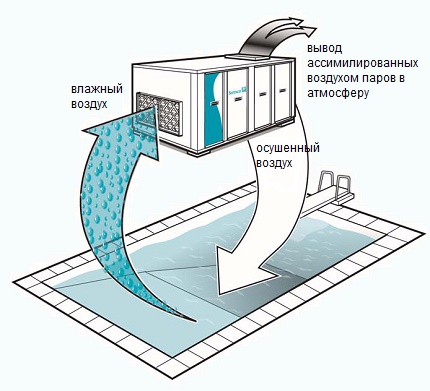
The second option does not please with the impressive energy losses spent on adsorption with moisture condensation and on subsequent calcination of the adsorber. However, it is more practical.
The systems operating on the basis of adsorption are produced, for example, by the Swedish company Munters, but they are used mainly for equipping public sports complexes, industrial and food warehouses, and production shops.
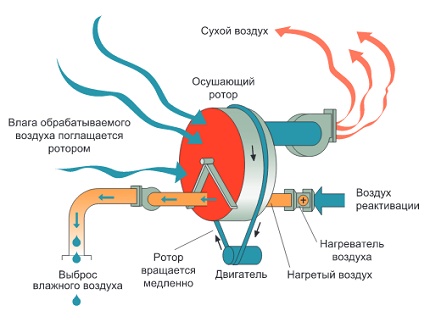
The high cost and senseless energy losses of two outdated methods forced us to look for more affordable economic and technological ways to equip private pools.
As a result, new devices for dehumidification of air have been developed that work on the principle of standard air conditioners. Drying machines are not much different from them in design and require equivalent maintenance care.
The models of dehumidifiers currently in use are equipped with a fan, compressor, hydrostat, radiators. Their action is based on the principle of condensation. A fan mounted in the device captures moist air from the room with the pool and directs it to the condensing unit.
The air removed from the condensate is discharged back into the room, and the condensate separated from the moist air mass is collected in a sump and discharged through the drainage channel.
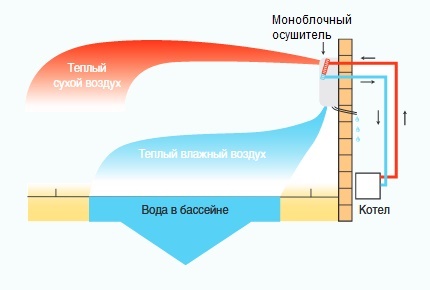
Devices that remove excess moisture through condensation operate in full or partial recirculation mode. Full recirculation involves the cyclical movement of air flow within the premises without changing its composition.
Such dehumidifiers are good at handling air in small private pools that do not require constant updating of the air composition.
If there is a desire to improve the quality of the air flow or there is a need to increase the oxygen content and reduce the share of carbon dioxide due to the duration of bathing sessions, then it is better to purchase a dehumidifier connected to the ventilation system or directly to the street.
It will provide an opportunity to update the composition of the air, periodically mixing fresh portion into the drained air stream.
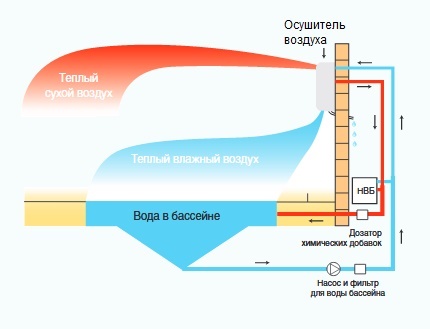
In addition to the ability to mix portions of outdoor air, a number of models of dehumidifiers are supplemented by the functions of heating the water and the air itself, and perform filtering and ionization actions. The drained air flow is heated by a water or electric circuit. The first will cost less both when buying and when operating.
If you are interested not only in the normalization of the humidity level, but also in the formation of the most comfortable conditions, then you should study the functionality of several units in advance in order to select and give preference to a position that has the required capabilities.
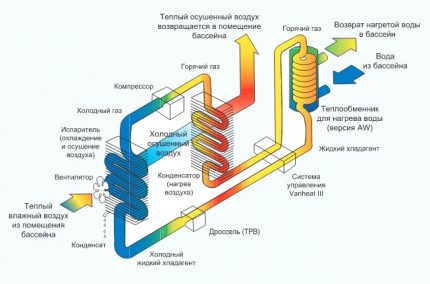
Design and installation differences
We found that the predominant number of market offers in the segment of air drying machines for artificial ponds is represented by condensing devices.
According to the installation method, they are divided into:
- Mobile Small monoblock machines, buy them for small pools and saunas, if the area of the water mirror does not exceed 40 m2. Basically, these are compact floor versions or wall modifications with the possibility of installation on the floor.
- Stationary These are channel systems designed for air treatment in pools with an evaporation area of over 40 m2. Oversized floor units that can be installed both in a separate ventilation room and in a swimming room.
When installed in a separate compartment, a ventilation chamber, channel dehumidifiers are connected to a duct system mounted in the walls or ceiling of a pool. Given the specific environment in air duct device desirable to use plastic constructions.
You can equip a ventilation chamber for a channel dehumidifier in the basement of a house with a pool or in the attic.
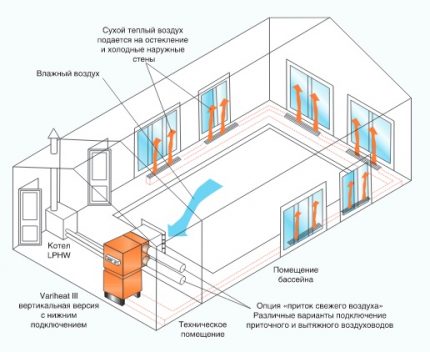
Note that the division of processing capabilities is rather arbitrary, because Among compact devices there are dehumidifiers capable of processing pools with an evaporation area of 70 - 100 m2. And if a similar wall & floor unit is built into a partition, it automatically goes into the category of stationary systems.
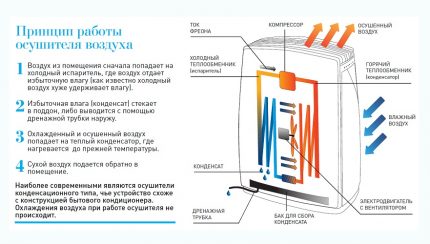
Typical layouts
Systems for ensuring a favorable microclimate in a room with a swimming pool are equipped in accordance with one of the typical schemes.
Option number 1. The easiest and cheapest way to reduce the humidity level in the pool is to install monoblock wall or floor dehumidifiers in an amount of 2 to 5 pieces, depending on the actual area of evaporation.
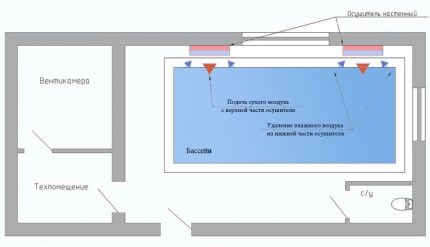
Option number 2. Partial recirculation scheme, i.e.with the intake of a fresh portion of air from the street, which is mixed with the drained and heated air mass captured in the pool.
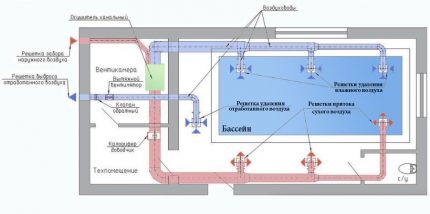
Option number 3. Channel systems are used that are installed in separate compartments. Dehumidifiers are combined with supply and exhaust ventilation, which guarantees complete air exchange in the pool hall.
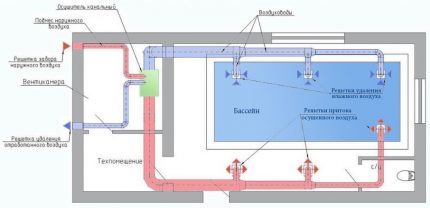
Option number 4. The scheme uses wall mounted or simply mounted dehumidifiers, the operation of which is not connected with supply and exhaust ventilation. The dehumidifier is turned on when the humidity level set by the pool owner is exceeded.
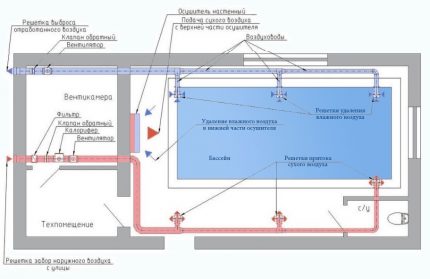
Option number 5. Wall mounted monoblock dehumidifier works in tandem with supply and exhaust systemperforming partial drainage of air mass in the pool.
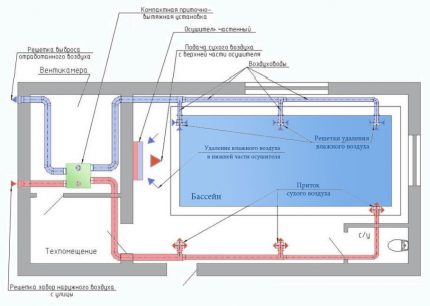
Based on the typical solutions proposed for consideration, you can choose the best option for arranging your own pool or improve one of the most suitable ventilation options according to specific specifications.
Features of the installation of dehumidifiers
Before installing any model of air dryer, you should thoroughly study the instructions supplied by the manufacturer with your product. The cooling system of machines operating on the principle of condensation of excess moisture is filled with refrigerant. Despite assurances of the safety of the substance, leakage and discharge into the environment must be eliminated.
The installation location of the device, regardless of its design features, must take into account:
- the ability to access for maintenance and repair work;
- all risks associated with a probable emergency refrigerant leak;
- permissible distance from objects that pose a threat to direct contact of the electric machine with the flow of water.
Such objects include directly the pool bowl, whirlpool bath, shower, fountain, water tank. According to European standards, there should be a minimum of 2 m between the water source and electrical equipment.
In the event of a refrigerant leak, the threat of exposure must be minimized. Upon detection, the work of artificial ventilation should be strengthened and supplemented with natural ventilation methods.
The accumulation of matter occurs in the lowest places, poorly covered by the flow of circulating air. Due to stagnation and accumulation, the concentration of the refrigerant can reach dangerous values.
Direct contact of the refrigerant with a hot surface and an open flame is not allowed, as when heated, the substance decomposes into toxic components. It is required to exclude contact with exposed skin and eyes. Spilled refrigerant must not be allowed to flow into the sewer, so as not to create gas plugs in the pipeline, a common cause of water hammering.
If a minor leak is detected, the substance should simply be allowed to evaporate. If there is a serious discharge, it is necessary to increase the intensity of the ventilation, localize the refrigerant with sand or at least ordinary soil and call the repairmen.
Installation of monoblock wall model
Most modifications of wall-mounted dehumidifiers are available in versions used for floor installation and hanging on purpose on a vertical surface. In the first case, the legs are screwed to the case, and the equipment acquires the status of a mobile dehumidifier. In the second, everything is extremely simple - the case through mounting loops is fixed to the wall with m8 screws.
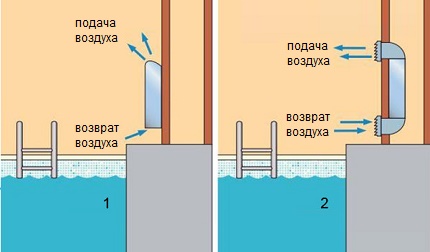
We will analyze the specifics of mounting a wall model from HldROS SBA series. Consider an installation option with embedding in a partition by means of drained chambers.
We will carry it out as follows:
- We attach two ventilation chambers to the dehumidifier body on top and bottom so that their working side is deployed to the surface to be treated. We use Ø 3.5 screws to fix the cameras.
- We dismantle the machine body for connecting water pipes and installing electrical connections.
- We connect a coil designed to heat water, and a drainage sleeve designed to drain condensate.
- We connect the power cable to the terminal board located in the control box.
- We carry out all the grounding nodes indicated by the manufacturer of the dryer.
- We check the quality of the formed nodes and the performance of the system.
- We assemble the case and fix its details in the same places.
Regularly, every six months, maintenance of the drying machine should be carried out.
During the scheduled maintenance, it is necessary to check the operation of the safety and control units, to make sure that there are no water leaks from the coil and refrigerant from the cooling system. It is necessary to check the condition of the air filters, if necessary, they should be measured, the balancing of the fan blades should be checked.
At the end of the season, maintenance is carried out in the above order, but is supplemented by a mandatory drainage of the water circuit.
The construction of the channel modular system
Installation of modular systems with channel dehumidifiers should be carried out in accordance with a pre-designed design. In development, the optimal route of ducting and the best installation location of the machine are selected. Let's consider the device options using the Calorex Variheat III brand systems as an example.
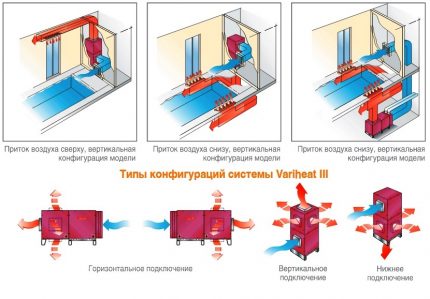
The equipment is produced in the format of prefabricated modules, due to which it is performed:
- Vertical installation of a dehumidifier with the supply duct located above in the area of the upper ceiling, behind a suspended ceiling or along the line connecting the ceiling and an adjacent wall.
- The vertical location of the drying machine with the installation of the supply duct at the radiator level under the window openings. Processing air is taken at the level of the upper dehumidifier module.
- Horizontal arrangement of the main unit of the system with lateral connection of air ducts. The air intake for drainage and the supply of treated mass is almost the same.
The optimal layout of equipment and air ducts are selected in accordance with the individual characteristics of the main and utility rooms of the pool.
Design and calculations for the selection of equipment
For the proper selection of equipment, it is necessary to calculate the evaporation rate. The calculations are carried out according to the formula regulated by the European standard VDI 2089.
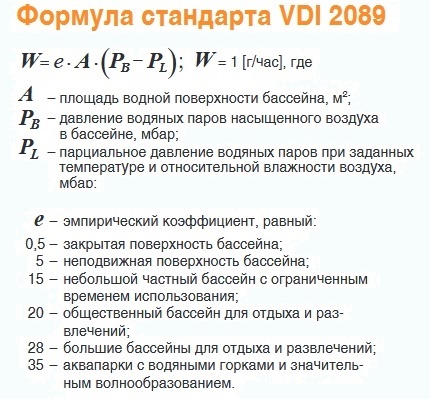
We calculate the evaporation rate for a small private pool with a water mirror area of 30 m2. We will take the temperature of the water in the pool bath equal to + 28ºС, the air temperature in the swimming pool + 29ºС, the value of the water vapor pressure in the room RB take 33.6 mbar. Assume that the recorded air humidity is 65%.
First you need to calculate *RL - the value of the partial pressure of evaporating water. Find the value for its calculation RL100 (with humidity parameters 100%) according to the table of gradation of elasticity of saturated water vapor.
This elasticity depends on the temperature of the water in the pool bowl. According to the conditions accepted by us, this is 40.07 mbar, which must be multiplied by 0.65 (humidity value, reduced to unity).
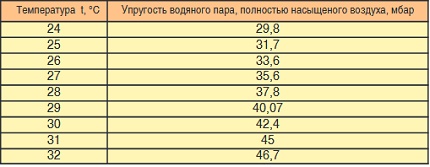
RL100 (value at 100% humidity) × 0.65 (65%) = 40.07 × 0.65 = 26.05 mbar
W = e × A × (PB - RL) = 15 × 30m2 × (33.6 mbar - 26.05 mbar) = 3397.5 g / h ≈ 3398 g / h = 3.398 kg / h
When taken as a basis in the example data from 1m2 0.11 kg of moisture will evaporate in the pool.
This is a simplified scheme for calculating the evaporation rate, but you can also use another method used in the UK if you wish.

Conclusions and useful video on the topic
Video # 1. Purpose and principle of operation of the device for draining air in the pool:
Video # 2. How monoblock dehumidifiers work:
Video # 3. What is a channel drainage unit:
The choice of a device for drying air in the pool is a serious matter, which should be approached thoughtfully and thoroughly. The information we offer will certainly come in handy for the pool owner who wants to equip his beloved property ideally, but without extra costs.With the mind, the selected equipment will work perfectly and adequately serve.
How did you choose and install the equipment for drying the air in your pool? Share technical criteria that justified the purchase and installation nuances that will be useful to site visitors. Please write comments in the block below, post a photo, ask questions.

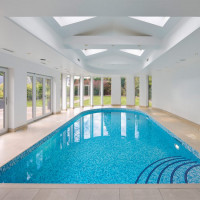 Organization of ventilation of the pool: the best methods of organizing air exchange
Organization of ventilation of the pool: the best methods of organizing air exchange  Materials for waterproofing pools: a comparative review
Materials for waterproofing pools: a comparative review 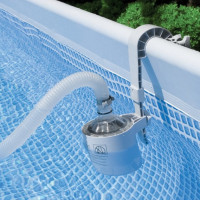 How to choose a pump for the pool: a comparative overview of different types of units
How to choose a pump for the pool: a comparative overview of different types of units 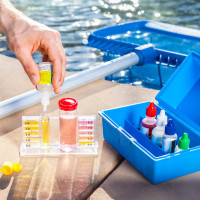 Coagulants for water purification in the pool: how to choose + application rules
Coagulants for water purification in the pool: how to choose + application rules 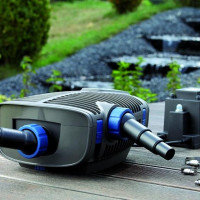 Pumps for fountains and waterfalls: how to choose and install yourself
Pumps for fountains and waterfalls: how to choose and install yourself 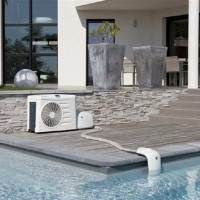 Pool heat pump: selection criteria and installation rules
Pool heat pump: selection criteria and installation rules  How much does it cost to connect gas to a private house: the price of organizing gas supply
How much does it cost to connect gas to a private house: the price of organizing gas supply  The best washing machines with dryer: model rating and customer tips
The best washing machines with dryer: model rating and customer tips  What is the color temperature of light and the nuances of choosing the temperature of the lamps to suit your needs
What is the color temperature of light and the nuances of choosing the temperature of the lamps to suit your needs  Replacement of a geyser in an apartment: replacement paperwork + basic norms and requirements
Replacement of a geyser in an apartment: replacement paperwork + basic norms and requirements
Is it possible to put only a dehumidifier into a 4 m long 3 m wide swimming pool? Will there be enough of it so that there is no condensation on the walls and windows? Or will you have to do ventilation in the whole building? Installers recommend taking a duct dehumidifier with fresh air from the street and air outlets. Advise how to avoid excessive humidity in the room at the lowest cost.
One dehumidifier can not cope with the humidity of the pool, in any case, you also need to do normal ventilation. The logic is simple - ventilation will remove most of the excess moisture, and if the excess goes, then the dehumidifier works.
Our pool is arranged not in the open territory, but inside the building. Therefore, to prevent bacteria from growing in the room due to moisture, there is no mold, which will negatively affect people's health, I purchased wall-mounted dehumidifiers. This is a very convenient thing, and most importantly it is automated, due to which it well maintains a given humidity inside the room itself.
Often a dehumidifier is not needed for a pool in a private house. They put it instead of fixing hack builders with waterproofing the basement. The reason must be corrected.